Podcast: Play in new window | Download
Sue Pryke | Episode 941
Sue Pryke’s work is concerned with functionality and the exploration of tactile surfaces to create tableware. Sue uses slip casting as a vehicle to produce domestic ware which is a nod to an industrial method of making, but use it in a craft setting to make pared-back contemporary ware that industry would find difficult to produce. Sue is inspired by the everyday and the ordinary, tactility and utility, material qualities, and the interaction we have with objects. Small details and preferences which reflect the intuitive decision making we all make on a daily basis when choosing what cup to take from the cupboard for a cup of tea.
SPONSORS
 You can help support the show!
You can help support the show!

Number 1 brand in America for a reason. Skutt.com

For all your ceramic needs go to Georgies.com
Do you see a difference between modern design and contemporary design?
Well I guess if you think about modern design you think of mid-century modern as opposed to contemporary. Or are you imagining that modern is contemporary?
Yes, modern seems more mid-century, so there’s a fifties and sixties vibe that goes with that.
Yes, so I think that the difference is contemporary design is slightly more paired back. Certainly what I do, I try to sort of take any sort of flair or hint of curls and twirly bits out and just make the forms very, very sleek. And take away the details and the flourishes. I think mid-century modern, I think was probably more organic then perhaps design now. But also with huge influences with what was going on perhaps in aviation and many other industries. I think we take some of that flair out nowadays and it’s a bit more straightforward.
What are the key characteristics, in terms of ceramics, for contemporary design?
So I think it’s not necessarily about functionality, although when we were writing the recent book obviously that’s about tableware that you can use, but I think functionality has changed because we’ve changed in our habits and the way that we eat. So in terms of tableware, we don’t have the same sort of shapes. A casserole for instance, a casserole are very sort of sixties and seventies. We don’t cook the same way, we would probably put it in a slow cooker or an air fryer. We have become far more cosmopolitan in how we eat and how we want our plates to look.
Is there a color palette that defines contemporary work?
Yes, that’s interesting isn’t it, because if you think of throwers it tends to be very organic. Maybe we are going back to a sort of sixties revival with soda fired and wood fired with those lovely rusty blushes from the firing process and that brash sort of palette isn’t so visible anymore. I am sure it’s still there. I think we have toned it down a little bit and tried to find something far more organic.
Why do clean and sleek lines fit more into the contemporary design? What makes that more definitive for it?
Well I suppose ceramic style and trends or fads in any design a lot of it comes down to how we are designing other products. If we think of architecture are housing being built with all the flourishes as they were in the Victorian era? They are not here. That’s for sure. It’s paired back and minimal. It’s big open spaces and clean lines, you know, very Scandinavian or Japanese even So I think the world is just following a trend and ceramics is just picking up on that.
Do you feel like contemporary work fits better in restaurants than say other styles?
Actually not necessarily. Restaurants might want that consistency, for me and my collection of tableware, but in the book we’ve covered a few of the potters. One example is Odd Standard who are Norwegian and some of the pieces they make for restaurants is clearly handmade, it’s more sculptural, and one piece is completely different from the next. So I think restaurants they might be looking for consistency and continuity in the range that I make but I think restaurants are becoming far more interested in what craftspeople can offer them now.
What’s your favorite Linda Bloomfield memory with working with her?
I think with Linda when you ask her a question she gives you a direct answer. You don’t get the froufrou with it, you get a direct answer. If you ask her, I want to make this glaze, I want a pink satin glaze. She will tell you exactly how to make that pink satin glaze. And that’s how I think of Linda. If you want to ask her a question, it’s fine to ring her up because you won’t have to say, And how are you? I am fine thank you. She will get straight to the point and tell you exactly what you need to know. So she is very helpful and generous with her knowledge.
Books

Design and Create Contemporary Tableware by Linda Bloomfield and Sue Pryke

Four Thousand Weeks by Oliver Burkeman
Contact
Instagram: @suepryke



 GRPotteryForms.com
GRPotteryForms.com







